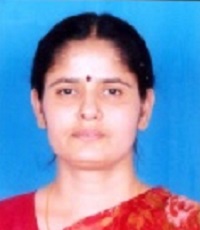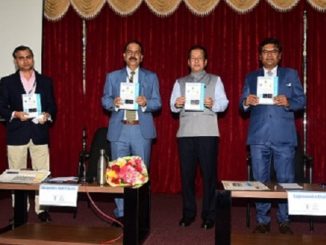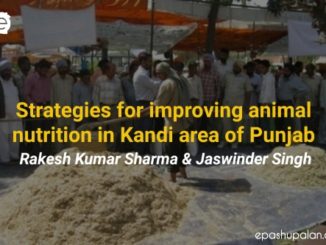Introduction
The primary purpose of raising poultry is to transform feeds into meat and eggs. But the feed conversion to these uses must be done efficiently and economically. To do this, the principles of nutrition must be applied; and they must be augmented by superior breeding, good health, and competent management. Poultry nutrition is more critical than that of other farm animals with regards to a number of factors. This is so because birds are quite different from other livestock; their digestion is more rapid, their respiration and circulation are faster, their body temperature is 8℉ to 10℉ higher, they are more active, more sensitive to environmental influences, they grow at a more rapid rate and they mature at an earlier age. Knowledge of the basic functions of the nutrients in the body and of the interrelationships between various nutrients and other metabolites within the cells of bird is necessary before one can make practical scientific use of the principles of nutrition.
The important food substances of poultry nutrition include carbohydrates, fats, proteins, minerals, vitamins, and water. Among these; minerals are as important as amino acids and vitamins to maintain life and production in poultry. Minerals are inorganic elements, frequently found as salts with either inorganic elements or organic compounds. Minerals are required for the formation of the skeleton, as parts of hormones or as activators of enzymes, and for the proper maintenance of necessary osmotic relationships within the body of the birds. Some minerals are required by poultry in relatively large amounts. They are referred to as major or macrominerals. Others are needed in very small amounts; they are referred to as trace or microminerals. The major or macrominerals of importance in poultry are calcium, phosphorous, sodium, chlorine, magnesium, potassium and the trace or microminerals of significance are magnesium, iron, zinc, copper, iodine, molybdenum, and selenium.

Most pertinent facts relatives to poultry minerals
1. Calcium (Ca)
Functions of Calcium: Bone formation, egg shell formation, blood clotting, neuromuscular impulses transmission, rhythmic heart activity, acid-base balances
Deficiency symptoms: Anorexia, thin eggshells, rickets, osteoporosis, abnormal gait, internal haemorrhages, tetany, frequent bone fractures
Effects of excess calcium intake: Nephrosis, visceral gout, atrophy of parathyroid glands, concomitant hypophosphatemia, interferes with utilization of magnesium, manganese and zinc.
Practical sources of calcium: Dicalcium phosphate, limestone, oyster shell, bone meal etc.
Recommended allowances: Vary with level of production and temperature. Minimum of 3.4% for layers in moderate climates and 0.8-0.9% in growing rations. Less than 1.2% in pullets of age below 20 weeks.
2. Phosphorous (P)
Functions of Phosphorous: Bone formation, metabolism of carbohydrates and fats, a component of all living cells, maintenance of acid-base balance of the body, calcium transport in egg formation, part of nucleic acid
Deficiency symptoms: Anorexia, weakness, rickets, cage-layer fatigue, stunted growth and if prolonged, mortality.
Practical sources of phosphorous: Defluorinated phosphate, dicalcium phosphate, monosodium phosphate, phosphoric acids, steamed bone meal
Recommended allowances: depends on production. Ratio of Ca:P for growing chickens (upto 20 weeks) 1.5 to 2.0 : 1 and for layers it can be 4.5 to 6.0 : 1
3. Sodium (Na)
Functions of Sodium: chief extracellular cation, regulation of osmotic pressure, fluid volume and acid-base balance, nerve impulse conduction, amino-acids absorption
Deficiency symptoms: Reduced utilization of proteins and energy, reduced growth rate, corneal keratinization, reduced cardiac output, reduced fluid volume, increased haematocrit and blood urea level, cannibalism. If prolonged, death.
Effect of excess sodium intake: excessive thirst with more watery faeces and water intoxication or dehydration symptoms depending on loss of sodium ion.
Practical sources of sodium: Common table salt
Recommended allowances: use of NaCl 0.2 – 0.5% of the diet
4. Chlorine (Cl)
Functions of chlorine: chief anion in extracellular fluid, HCl production in stomach, helps regulates body pH
Deficiency symptoms: Practically rare, poor growth, high mortality, nervous symptoms, hyperexcitability and reduced blood chloride level
Practical source of chlorine: Common table salt
Recommended allowances: use of NaCl 0.2 – 0.5% of the diet
5. Potassium (K)
Functions of Potassium: chief intracellular cation, involve in acid-base balance and osmotic pressure regulation, muscle activity, increase membrane permeability to facilitate absorption of neutral amino acids, influences carbohydrate metabolism, activates some enzymes
Deficiency symptoms: weakness of respiratory, cardiac and skeletal muscles, retarded growth and mortality in chicks
Practical source of potassium: corn contains 0.33% potassium and other cereals contain 0.42-0.49% potassium.
Recommended allowances: Generally potassium is not deficient in rations; due to large amount of plants products in poultry.
6. Magnesium (Mg)
Functions of Magnesium: Essential for normal skeletal development, as a constituent of bone, enzyme activator, primarily in glycolytic system
Deficiency symptoms: Stunted growth, inactive, panting, gasping, decreased egg production, convulsions, reduced egg and shell weight.
Effect of excess magnesium intake: Wet droppings, reduced shell thickness
Practical source of magnesium: Magnesium oxide or magnesium sulphate (Avoid use of High Mg containing dolomite limestone)
Recommended allowances: 600 ppm in the broiler ration , requirement of magnesium is affected by dietary calcium and phosphorous level.
7. Copper (Cu)
Functions of Copper: Essential element in various oxidase enzymes like ascorbic acid oxidase, amino oxidase, tyrosinase, necessary for haemoglobin synthesis and preventing nutritional nutritional anaemia.
Deficiency symptoms: anaemia, achromotrichia (depigmentation of feathers), aneurism of aorta, In poults marked cardiac hypertrophy
Practical source of copper: copper sulphate, copper carbonate
Recommended allowances: 6 to 8 ppm in ration
8. Iron (Fe)
Function of Iron: Component of Myoglobin and Haemoglobin (O2 transport), present in cytochrome oxidase, catalase and peroxidases enzymes.
Deficiency symptoms: Microcytic hypochromic anaemia in chicks and poults, low PCV (Packed Cell Volume) value; achromotrichia in coloured feather birds.
Practical source of iron: alfalfa meal, meat meal, fish meal, liver
Recommended allowance: Ration should contain 80 ppm of iron.
9. Iodine (I)
Functions of Iodine: Needed by thyroid gland to make thyroxine hormone which controls the rate of body metabolism (BMR) or heat production, growth of integuments and its outgrowth, differentiation and functioning of various tissues and organs.
Deficiency symptoms: Enlarged thyroid (goitre), cessation of egg production, fat accumulation in layers, abnormally long and lacy feathers, deterioration of egg shell quality, reduced hatchability, unabsorbed yolk and enlarged thyroid glands in embryos.
Practical source of iodine: stabilized iodized salts containing 0.007% iodine.
Recommended allowance: 300 ppb in layers and 350 ppb in growing chicks
10. Manganese (Mn)
Functions of Manganese: Necessary for growth, bone structure (mucopolysaccharide formation) and reproduction, helps in fatty acid and cholesterol synthesis; activates phosphatase enzymes.
Deficiency symptoms: Perosis / Slipped tendon associated with enlargement and malformation of tibiometatarsal joint, twisting and bending of tibia, shortened leg bones, skull deformation, parrot beak; poor egg production, poor shell quality and hatchability.
Practical source of manganese: Alfalfa meal, grains by products, manganese sulphate, manganese chloride, manganese carbonate, and Manganese dioxide.
Recommended allowances: ration should contains atleast 30 ppm for layers and 60 ppm for broilers.
11. Zinc (Zn)
Functions of Zinc- component of several enzymes like carbonic anhydrase, glutamic acid and alcohol dehydrogenase, carboxypeptidases, calcification of bone and formation of egg shells; also needed for normal protein synthesis and metabolism and a component of insulin
Deficiency symptoms– frizzled or ruffled feathers, stunted growth, enlargement of hock joints, bone problem, inappetence, scaly skin; reduced egg production, hatchability and mortality in severe case.
Practical source of zinc- zinc carbonate or zinc sulphate.
12. Selenium (Se)
Functions of Selenium: Involve in destruction of peroxidases within the cell as a constituent of GSH (Glutathione Peroxidase); aids in absorption and retention of vitamin E
Deficiency symptoms: exudative diathesis, pancreatic fibrosis, steatitis, muscular dystrophy, reduced growth rate and increased mortality and myopathies of gizzard and heart in turkeys.
Effects of excess selenium intake: feeding selenium 100 times more than the requirement may results in reduced growth and egg production.
Practical source of selenium: fish meal, brewers dried yeast, sodium selenite or sodium selenate.
Recommended allowances: 0.2-0.3 ppm
13. Molybdenum (Mo)
Function of Molybdenum: constituent of xanthine oxidase enzyme which catalyses oxidation of purines.
Deficiency symptoms: stunted growth, reduced xanthine dehydrogenases level in the liver.
14. Cobalt (Co)
Functions of Cobalt: part of vitamin B12 enzymes; hence all functions and deficiency symptoms of cobalt are similar to that of vitamin B12.
Almost all the feed ingredients that are added in poultry diets provides all essential minerals, but the mineral concentrations in various ingredients are variable due to several factors such as adulterants, agro-climatic conditions, toxic attributes and processing conditions. Simply by addition of animal or vegetable feedtuff to poultry diets, the requirements of various minerals may not be fulfilled and may require extra-supplementation with inorganic mineral sources. Therefore; a large number of mineral supplements are available in the markets. The minerals are supplemented either through a readymade mineral mixtures or through specific mineral salts.
Table – Composition of Mineral Mixture for Poultry
| Mineral Supplement | Broiler Diet | Layer Diet |
| Limestone (%) | 1-2 | 5-7 |
| Bone meal / Dicalcium Phosphate (%) | 1-2 | 1-2 |
| Copper sulphate (mg/kg) | 20-25 | 20-25 |
| Ferrous sulphate ( mg/kg) | 200-250 | 200-250 |
| Manganese sulphate (mg/kg) | 100-150 | 200-250 |
| Potassium iodide (mg/kg) | 1 | 1 |
| Sodium Chloride (%) | 0.3-0.5 | 0.3- 0.5 |
| Zinc sulphate (mg/kg) | 200-250 | 200-250 |
Table – Suggested Nutrient requirements for Broilers and Layers (BIS-2007)
| Characteristics | Broiler Pre-starter
(0-7 day) |
Broiler Starter
(8-21 days) |
Broiler
Finisher (22 day onwards to finish) |
Layer
Chick Starter |
Layer
Grower |
Layer
Phase- I (21-45 weeks) |
Layer
Phase- II (46-75 weeks) |
| Calcium % (min) | 1 | 1 | 1 | 0.50 | 0.50 | 0.50 | 0.50 |
| Phosphorous%(min) | 0.45 | 0.45 | 0.45 | 1 | 1 | 3 | 3 |
| Manganese (mg/kg) | 100 | 100 | 100 | 90 | 50 | 55 | 55 |
| Iodine (mg/kg) | 1.20 | 1.20 | 1.20 | 1 | 1 | 1 | 1 |
| Iron (mg/kg) | 80 | 80 | 80 | 120 | 90 | 75 | 75 |
| Zinc (mg/kg) | 80 | 80 | 80 | 60 | 50 | 75 | 75 |
| Copper (mg/kg) | 12 | 12 | 12 | 12 | 9 | 9 | 9 |
| Selenium (mg/kg) | 0.15 | 0.15 | 0.15 | —- | —- | —- | —- |
Table- Nutrient requirement for Broilers (ICAR 2013)
| Characteristics | Broiler chicks
(0-4 weeks) |
Broiler Growers
(5-18 weeks) |
Broiler Pre-breeder (19-23 weeks) | Broiler Breeder
(24 weeks onwards) |
Broiler Males
(24 weeks onwards) |
| Calcium % (min) | 1.0 | 1.0 | 1.5 | 3.0 | 0.90 |
| Phosphorous%(min) | 0.45 | 0.45 | 0.38 | 0.35 | 0.30 |
| Manganese (mg/kg) | 100 | 120 | 120 | 100 | 120 |
| zinc(mg/kg) | 100 | 100 | 120 | 100 | 120 |
| Iron (mg/kg) | 80 | 80 | 80 | 80 | 80 |
| Copper (mg/kg) | 20 | 20 | 20 | 20 | 20 |
| Iodine (mg/kg) | 2.0 | 3.0 | 3.0 | 2.5 | 2.5 |
| Selenium (mg/kg) | 0.3 | 0.3 | 0.3 | 0.3 | 0.35 |
Table- Nutrient requirement for Layers (ICAR 2013)
| Characteristics | Laying pullets
(0-8 weeks) |
Laying pullets
(8-16 weeks) |
Laying pullets (16-18 weeks) | Cockrel
(0-4 weeks) |
Cockrels
(4-10 weeks) |
| Calcium % (min) | 1.0 | 0.80 | 2 | 0 | 0.85 |
| Phosphorous%(min) | 0.4 | 0.35 | 0.32 | 0.41 | 0.38 |
| Manganese (mg/kg) | 50 | 40 | 40 | 50 | 45 |
| zinc(mg/kg) | 40 | 35 | 35 | 40 | 40 |
| Iron (mg/kg) | 60 | 60 | 60 | 60 | 60 |
| Copper (mg/kg) | 8 | 5 | 5 | 8 | 8 |
| Iodine (mg/kg) | 0.35 | 0.35 | 0.35 | 0.35 | 0.35 |
| Selenium (mg/kg) | 0.15 | 0.10 | 0.10 | 0.15 | 0.15 |
| Sodium (%) | 0.15 | 0.15 | 0.15 | 0.15 | 0.15 |
| Chloride (%) | 0.15 | 0.12 | 0.12 | 0.15 | 0.15 |
Conclusion
Each of the mineral has a specific metabolic function and hence; its deficiency or excess will precipitates in one or the other form of disease resulting in poor performance by the birds. Several factors influences the requirements of minerals like breed and age of the chicken, level of production, animal adaptation, chemical form, interrelationship with other elements. Therefore; liberal supplements of minerals should be included in the poultry diet to meet the essential requirements as per the need of body with a suitable margins of safety.









Be the first to comment